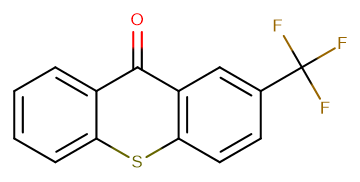
2-Trifluoromethyl thioxanthone
CAS No. 1693-28-3
2-Trifluoromethyl thioxanthone( —— )
Catalog No. M12580 CAS No. 1693-28-3
It is a pale yellow crystal. with molecular fomula C14H7F3OS.
Purity : >98% (HPLC)
 COA
COA
 Datasheet
Datasheet
 HNMR
HNMR
 HPLC
HPLC
 MSDS
MSDS
 Handing Instructions
Handing Instructions
| Size | Price / USD | Stock | Quantity |
| 5MG | 37 | In Stock |


|
| 10MG | 45 | In Stock |


|
| 25MG | 61 | In Stock |


|
| 50MG | 98 | In Stock |


|
| 100MG | 129 | In Stock |


|
| 200MG | 181 | In Stock |


|
| 500MG | Get Quote | In Stock |


|
| 1G | Get Quote | In Stock |


|
Biological Information
-
Product Name2-Trifluoromethyl thioxanthone
-
NoteResearch use only, not for human use.
-
Brief DescriptionIt is a pale yellow crystal. with molecular fomula C14H7F3OS.
-
DescriptionIt is a pale yellow crystal. with molecular fomula C14H7F3OS.
-
In Vitro——
-
In Vivo——
-
Synonyms——
-
PathwayOthers
-
TargetOther Targets
-
RecptorOthers
-
Research Area——
-
Indication——
Chemical Information
-
CAS Number1693-28-3
-
Formula Weight280.26
-
Molecular FormulaC14H7F3OS
-
Purity>98% (HPLC)
-
SolubilitySoluble in DMSO
-
SMILESFC(F)(F)C1=CC2=C(SC3=CC=CC=C3C2=O)C=C1
-
Chemical Name——
Shipping & Storage Information
-
Storage(-20℃)
-
ShippingWith Ice Pack
-
Stability≥ 2 years
Reference
1. Enever RP, et al. J Pharm Sci. 1979 Feb;68(2):169-7
molnova catalog



related products
-
[(1(10)E,2R,4R)]-2-M...
[(1(10)E,2R,4R)]-2-Methoxy-8,12-epoxygemacra-1(10),7,11-trien-6-one is a natural product.
-
Platelet Membrane Gl...
Platelet Membrane Glycoprotein IIB Peptide (296-306)
-
11-Oxomogroside III
11-Oxomogroside III is a natural product from Siraitia grosvenorii Swingle.



 Cart
Cart
 sales@molnova.com
sales@molnova.com


